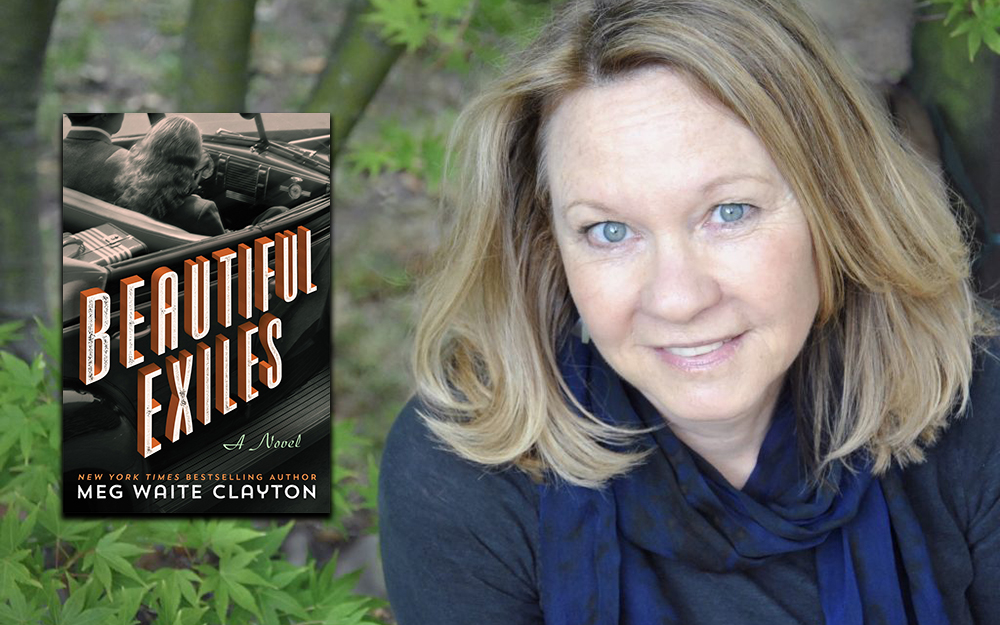
By Heidi Simmons
—–
Beautiful Exiles
by Meg Waite Clayton – Fiction
—–
There is a curiosity about how the famous and talented live and function. Accomplished musicians, actors, artists and writers give so much of themselves for their craft. Through their work, we often feel as though we know them personally. In Meg Waite Clayton’s novel Beautiful Exiles (Lake Union, 384 pages), literary giant Earnest Hemingway and Journalist Martha Gellhorn become lovers and rivals.
Historical fiction is certainly among the most entertaining reading. It’s exciting to drop into a world where the setting and events are familiar. But what makes historically based storytelling especially intriguing is all the behind the scenes information that is unfamiliar.
Clayton begins her story in 1994 with her first person character who is the real Martha Ellis Gellhorn, a war correspondent and author. She is in her mid-eighties with failing eyesight revisiting letters from her mother, Matie, ex-husband, Ernest, and other famous people that include H.G. Wells and Eleanor Roosevelt. After she reads a personal letter from Ernest, instead of donating it to archives in Boston, she tosses it into the fire and watches it burn.
The story goes back to the beginning in 1936, where on a trip to Key West with her mother and brother, Gellhorn meets Hemingway in a dive bar. She has already been published as a travel author and journalist, and much to Gellhorn’s surprise, Hemingway has read her work. Of course, she is keenly familiar with Hemingway’s work but is shocked to find that he knows her writing. They connect when they share their travel experiences and desire to cover the Spanish Civil War.
Gellhorn decides to stay in the Keys and Hemingway takes the young and beautiful writer under his wing. She meets and spends much of her time with Hemingway’s wife Pauline and their two sons. She and Hemingway decide to go to Spain together to cover the civil war where they bond under gunfire and bomb blasts. They also become lovers. By 1940, they marry in a small ceremony in Idaho. She was his third wife.
Author Clayton has Gellhorn tell her own story which gives this book gravitas it might not have with an omniscient voice. Gellhorn is smitten by the charming and famous Hemingway. She is also flattered by his interest in her and enjoys the added attention it brings. But, that quickly fades as she begins to realize he may be more of a hindrance than a help to her career — and life.
I had never heard of Gellhorn before this book and it was a pleasure to get to know her and her journalistic contributions. Besides what I learned about Hemingway in high school and what is commonly known, I never took the time to explore much more of his personal life. Had this been a nonfiction biography of Gellhorn, I’m not sure I would have sought it out. As a novel, I was engaged and intrigued by her writing career and her struggle to be married to a famous and irascible writer.
Before America joined the fight in World War II, Gellhorna traveled in Austria, Czechoslovakia, France and other countries filing stories for Colliers magazine. She went to China, where she was asked by President Roosevelt to spy.
Once America was in the fight, Gellhorn was not granted press credentials because she was female journalist. Even with a personal relationship with both President Roosevelt and the First Lady, she had to finagle ways to get to the front lines in Europe to report on the war.
This book is nearly equal parts Gellhorn and Hemingway. Together they were fueled by drinking, writing and the adrenaline of war. But, remove one of the triumvirate and they were not happy. What turned Hemmingway on also frightened him. He wanted his wife to stay at home with him, but she had to go where the action was. Which he did not like.
This historical adaptation shed new light on Hemingway for me. For the first time, I saw the man behind the writing – flawed and tormented. His personal life was infused into his writing. I went back and read some of Hemmingway’s short stories and I now see his personal fears and weaknesses permeate and perhaps drive his stories.
I also appreciated Gellhorn’s conflict of wanting to be respected for her own accomplishments and not because she was a famous man’s wife. Gellhorn is stronger and more competent than Hemingway but it’s almost blasphemy to acknowledge such. By all evidence, she was tougher, braver and brighter.
I especially liked Gellhorn’s progressive mother, Matie, who was a suffragette. Although she and Hemingway got on well together, she advised her daughter not to marry Hemingway. She warned her that her career may suffer and his name would overshadow her own. Matie was right. They were married only five years.
While together living in Cuba, Hemmingway wrote his Pulitzer Prize winning novel For Whom the Bell Tolls.
Martha Gellhorn is amazing and I’m grateful to be introduced to her through Clayton’s Beautiful Exiles. She does a terrific job bringing these two oversize personalities to life. Clayton’s research and expertise about Gellhorn and Hemingway is impressive and it shows on every page of her novel. Historical fiction is a wonderful way to get to know such talented and driven people and their place in time.











































